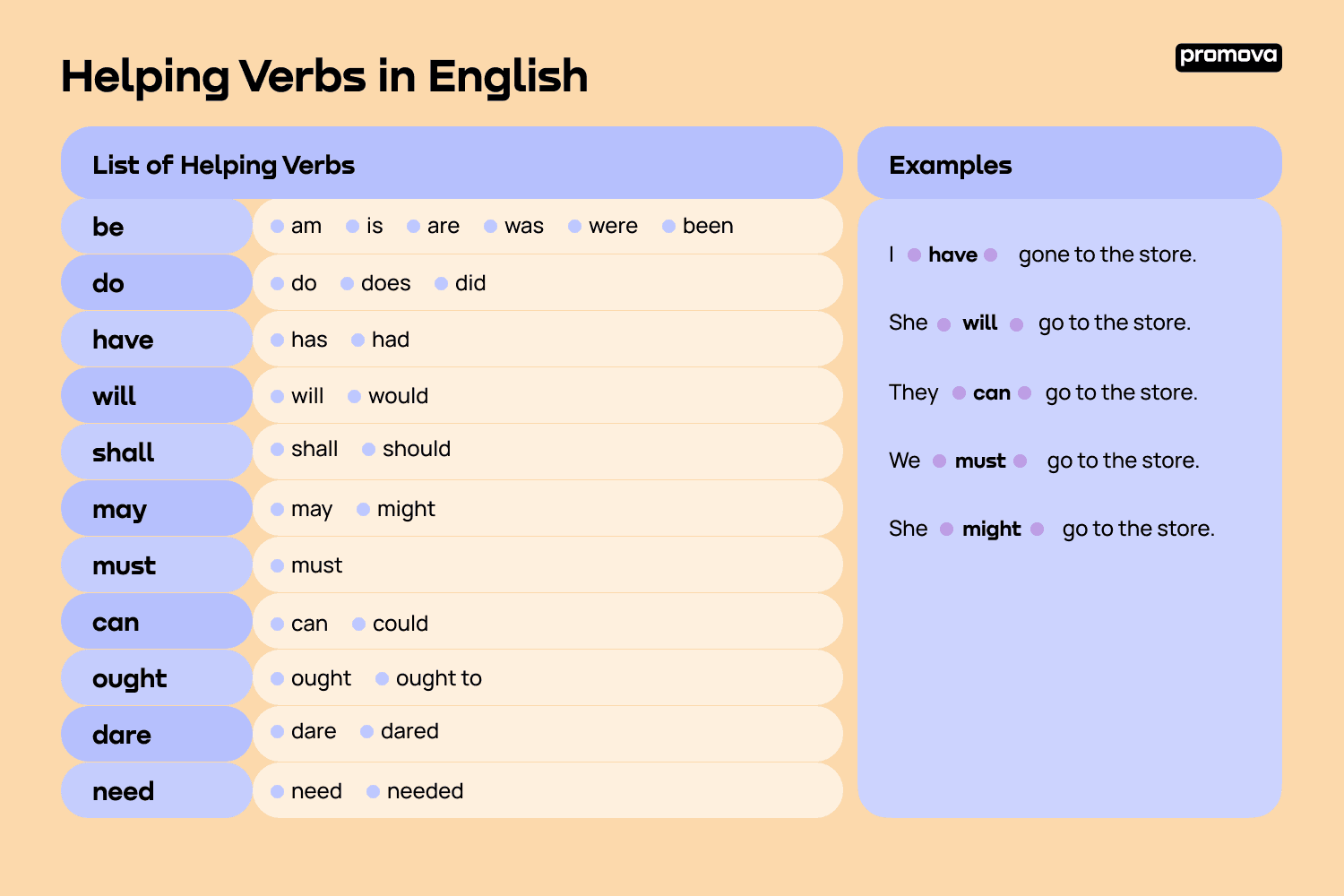Helping Verbs in English
Contents
In this reference, we'll delve deep into what helping verbs are, their importance, and how to use them.
We'll provide examples of helping verbs in sentences, as well as discuss commonly misused helping verbs and provide a list of helping verbs.
What is a helping verb?
A helping verb, which we also refer to as an auxiliary verb, works together with a main verb to add additional meaning to a sentence. Helping verbs are also used to make verb tenses, in particular, the progressive, perfect, and perfect progressive tenses. Helping verbs are also used to make questions and negative statements.
The most common helping verbs are be, do, have, and will. These four verbs are known as primary helping verbs, and they are used to create the most commonly used verb tenses.
The other helping verbs are known as modal auxiliary verbs, and they are used to create more complex verb tenses, such as the progressive, perfect, and perfect progressive tenses.
These are can, could, may, might, must, shall, should, would, ought to, had better, used to, need, and dare. They convey a variety of meanings, such as possibility, necessity, willingness, ability, and obligation.
The role of helping verbs
Helping verbs are important for adding meaning to a sentence. They help to convey the intended meaning of the sentence and make it easier to understand. For example, the sentence "I went to the store" is much clearer when it is written as "I have gone to the store." In this sentence, the helping verb "have" is used to indicate that the action of "going to the store" has already taken place.
Helping verbs are also important for creating verb tenses. Without them, it would be difficult to communicate which tense is in your sentence. For example, the sentence "I go to the store" could mean that the action of "going to the store" is either happening now or will happen in the future. However, if the helping verb "have" is added to the sentence, it means that the action of "going to the store" has already taken place.
7
How to Use Helping Verbs
In sentences, helping verbs are usually placed before the main verb. For example, in the sentence "I have gone to the store," the helping verb "have" is placed before the main verb "gone." However, there are exceptions to this rule. For example, in the sentence "I am going to the store," the helping verb "am" is placed after the main verb "going."
If you are unsure of which helping verb to use in a sentence, it is best to consult a dictionary. This will help you determine which verb is the most appropriate for the context of your sentence.
Examples of Helping Verbs in Sentences
Examples of helping verbs in sentences:
- I have gone to the store. (The helping verb "have" is used to indicate that the action of "going to the store" has already taken place.)
- She will go to the store. (The helping verb "will" is used to indicate that the action of "going to the store" will take place in the future.)
- They can go to the store. (The helping verb "can" is used to indicate that the action of "going to the store" is possible.)
- We must go to the store. (The helping verb "must" is used to indicate that the action of "going to the store" is necessary.)
- She might go to the store. (The helping verb "might" is used to indicate that the action of "going to the store" is possible, but not certain.)
Commonly Misused Helping Verbs
There are some commonly misused helping verbs. For example, many people mistakenly use the helping verb "did" when they should use "do". For example, the sentence "I did go to the store" is incorrect, as the helping verb "do" should be used instead of "did".
Another commonly misused helping verb is "can". Many people mistakenly use "can" to mean "must". For example, the sentence "I can go to the store" does not mean that you have to go there; it simply means that it is possible or that you are thinking about it.

List of Helping Verbs
Here is a handy list of helping verbs for reference:
- Be: am, is, are, was, were, been
- Do: do, does, did
- Have: has, had
- Will: will, would
- Shall: shall, should
- May: may, might
- Must: must
- Can: can, could
- Ought: ought, ought to
- Dare: dare, dared
- Need: need, needed
Summary
We hope this reference helped understand auxiliary verbs and how to use them correctly. These are verbs you can use to add additional meaning in a sentence and show things like possibility or necessity.
We recommend checking out our other learning resources for learners. With practice, you'll be able to master the use of helping verbs and communicate more effectively in English.



Comments